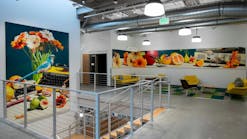I recently attended the Annual DOE sponsored R&D Program for Solid State Lighting. The conference had a cornucopia of professionals from the lighting and non-lighting industry. The DOE has been able to harness a positive environment where entities from all levels of the LED supply chain can participate and share. There were chip manufacturers, glass companies, materials/chemical firms, lamp/luminaire manufacturers, and designers all under the same roof and giving their perspective on where the industry is and should be heading.
The room was encouraging where competing manufacturers were complementing the achievements of their counterparts such as recognizing the Philip’s Hue Lamp, Cree beating the $10 price barrier, Soraa’s GaN on GaN breakthroughs, and many more.
The conference was focused on the current developments of the Solid State Industry and where the industry needs to head to gain market adoption. There was a big focus on efficacy and how it is very crucial for a rapid market adoption of LEDs.
The industry is working really hard, from the government to the manufacturers. But what does matter? What will get consumers excited and get them moving towards LEDs? CFLs took 30 years to gain big market traction, and that only happened when CFLs were close to the price point of incandescent lamps. Some of the issues that were labeled as being critical by the DOE to solve barriers to LED lighting adoption were the following:
- Improving efficacy of green LEDs
- Solving droop issues
- Improving light quality
- Investing in Quantum Dots technology
- Achieving 250lm/W luminaire efficacy by year 2020
As a quiet observer, I saw some disparities in the DOE’s vision and that of the lighting industry. Both sides agreed that LEDs were crucial to a better, more sustainable tomorrow, but opinions slightly differed when it came to discussing the path LEDs should take to become the lighting of the future. Some concerns of the lighting industry seemed to be:
- DOE should commit to some standard (e.g. Zhaga or others) so that manufacturers have some direction when building their product.
- Is solving droop and investing in Quantum Dots really necessary at this point to further adoption?
- Is the requirement of CRI 90 (such as in California) necessary, or does it add unnecessary pressure on manufacturers?
- Should the DOE develop new metrics to evaluate the performance of LED lighting rather than using the ones that were more applicable to incumbent technologies?
No doubt discussions were rich and captivating. This is a very critical time for LEDs; in these initial stages of adoption, it is crucial to make sure that investments are being made in the right areas to accelerate technological breakthroughs which can drive market adoption. No one knows what the future holds and where LEDs will end up. Fluorescent Lighting technology has been around for 30 years, and it still is competing with HIDs, halogens, and incandescent. Maybe LEDs will be able to have a faster evolution in the market if key factors of a sustainable market adoption are understood and solved.
Shonika Vijay | Analyst
B.S. in Engineering from the University of California Davis
Shonika Vijay is the analyst for the outdoor and replacement LED market at Strategies Unlimited. She was a consultant in energy efficiency with ADM Associates and DNV KEMA. She conducted evaluation, measurement and verification for utility and state sponsored energy efficiency programs and studies. She completed her Bachelors in Engineering from University of Davis, California





